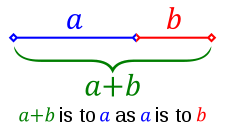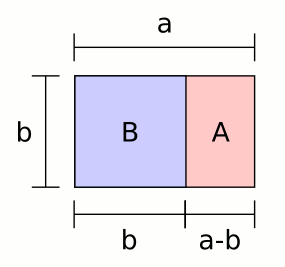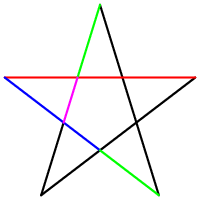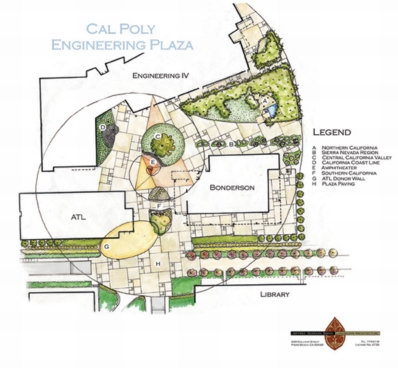Golden Ratio
GOLDEN RATIO
DEFINITION
It is said that two quantities are in a golden ratio also known under names golden section, golden mean [1], medial section, golden cut [2], extreme and mean ratio [3] when the following, expressed in algebraic form, is true:

In other words if the whole is to the larger as the larger is to the smaller. The golden ratio is irrational mathematical constant. Its value is 1.6180339887... The golden ratio is symbolised by the Greek letter ![]() (phi) and also by the less known τ (tau).
(phi) and also by the less known τ (tau).
This mathematical proportion is often recognized as 'aesthetically pleasing'. Because of that golden ratio found its use in many different fields like mathematics, architecture, geometry, science, biology, nature, art and design.
The actual discovery of the golden ratio can be lead back to the ancient Greeks and the Pythagoras. The greek mathematician Euclid of Alexandria (365BC - 300BC) mentioned the golden mean.
CALCULATION
Method for calculation of golden ratio constant is beginning from the following algebraic formula:
From the formula we obtain that a is equal b/![]() , so we can replace all occurences of a:
, so we can replace all occurences of a:
Devided by b formula changes to:
Now we need to multiply formula by ![]() and by moving content of the right side to the left side we get quadratic equation:
and by moving content of the right side to the left side we get quadratic equation:
The only positive result to above equation is the irrational number we have already presented:
GEOMETRY AND MATHEMATICS


Fibonacci introduced to us, the Fibonacci-Numbers:
1,2,3,5,8,13,21,34,55,89,144,233,377,....
Every number of this alignment equals to 0,168 if you divide it with the one before it, and 1,618 when you divide it with the number after it. These are the relationships between the larger and smaller numbers in the golden ratio. Below you can see example for division of bigger by smaller number:
and by smaller devided by bigger number:
There are many shapes in which golden ratio were discovered. Examples of those you can see on the right side.
ART & DESIGN
Since the beginning of ART & Design, the artist and designers used the golden ratio in order to manage and achieve beauty and balance in their creations.
The evidence of the golden ratio was proved on many different creations, like the Aztek decorations below:
[Brooker]
The space between the two heads is exacly Phi times the width of the heads.
The California Polytechnic State University is planing to build a new Engineering Plaza. This new construction is based on the Fibonacci numbers. The whole plan also bases on some shapes, which can be used to show the meaning of the golden ratio. The Designers of this new Plaza have chosen the Fibonacci series spiral, or also called the golden mean to design this new state of the art plaza. Below you can see, what the plaza should look like.
[Dr Knott, 1996-2005]
Even the mountainbike shown below, has the golden ratio built in. Take a look at the image, and the marked golden sections of the bike.
[Dr Knott, 1996-2005]
Mountainbike Trek Fuel 90 (belongs to Brian Agron of Fairfax)
So the use of the golden ratio can not only be found in ancient paintings and sculptures, but also in the stunning creations still to come.
Architecture
CONCLUSION
The very simple and suitable conclusion is that the Golden Ratio can be found everywhere. In probably any field you can think of. And in many, not all, but at least very many cases, the Golden Ratio is used to improve something. Some don't even know, that something they have created respects the laws of the Golden Ratio. This is kind of like the ancient egyptians, who probably used the Golden Ratio, but never thought of, and so never really discovered it.
So look for it, maybe you can discover an ancient theory in something quite modern...
Related Links
REFERENCES
[Wikipedia, Golden Ratio, 2005] Wikipedia.org, Golden Ratio, 19.10.2005, http://en.wikipedia.org/wiki/Golden_ratio
[Absoluteastronomy] Absoluteastronomy, Golden Ratio, http://www.absoluteastronomy.com/encyclopedia/g/go/golden_ratio.htm
[Kaphammel, 2000] Günther Kahammel, Der goldene Schnitt, 1. Auflage, Braunschweig, 2000
[Wikipedia, Golden rectangle, 2005] Wikipedia.org, Golden rectangle, 24.10.2005, http://en.wikipedia.org/wiki/Golden_rectangle
[Wikipedia, Pentagram, 2005] Wikipedia.org, Pentagram, 29.10.2005, http://en.wikipedia.org/wiki/Pentagram
[Brooker] Carolyn Brooker, The Golden Ratio in the Arts, University of Bath, http://students.bath.ac.uk/ma1caab/art.html
[Dr Knott, 1996-2005] Dr Ron Knott, Fibonacci Numbers and The Golden Section in Art, Architecture and Music, University of Surrey, 1996-2005, http://www.mcs.surrey.ac.uk/Personal/R.Knott/Fibonacci/fibInArt.html
[Batterywholesaler] Batterywholesaler, Credit Cards, http://www.batterywholesaler.co.uk/battery_images
[Obara] Samuel Obara, Golden Ratio in Art and Architecture, University of Georgia, http://jwilson.coe.uga.edu/EMT668/EMAT6680.2000/Obara/Emat6690/Golden%20Ratio/golden.html
[Livio, 2002] Mario Livio, The golden ratio and aesthetics, November 2002, http://plus.maths.org/issue22/features/golden/
- ↑ Template:Cite book
- ↑ Summerson John, Heavenly Mansions: And Other Essays on Architecture (New York: W.W. Norton, 1963) p. 37. "And the same applies in architecture, to the rectangles representing these and other ratios (e.g. the 'golden cut'). The sole value of these ratios is that they are intellectually fruitful and suggest the rhythms of modular design."
- ↑ Euclid, Elements, Book 6, Definition 3.



